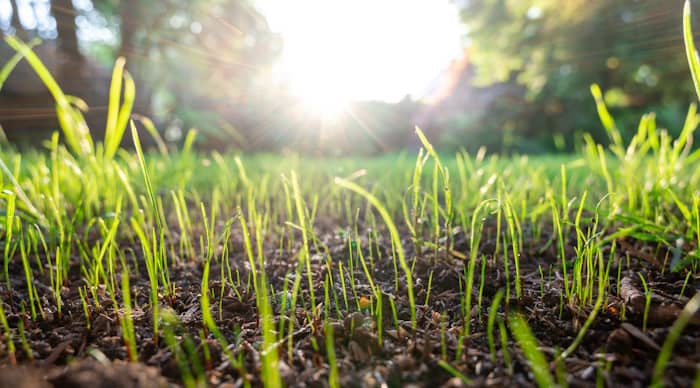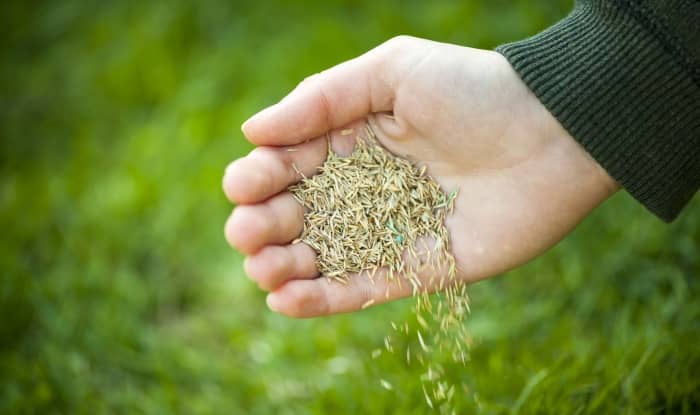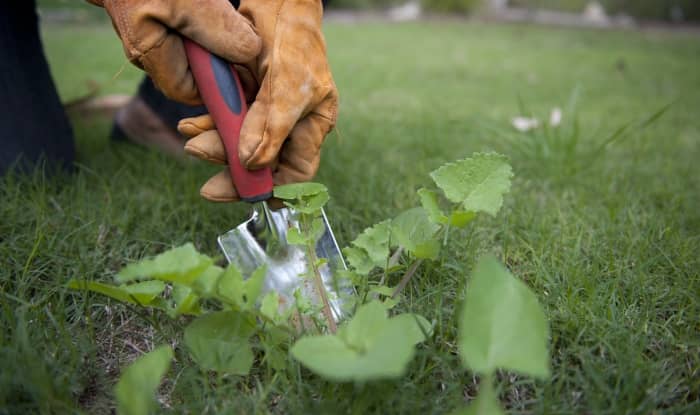I vividly recall the vibrant, promising sight of my freshly seeded lawn. I had invested countless hours nurturing the soil, diligently scattering the seeds, and watering them with an unexpected level of patience.
And then, my worst fear became a reality. Weeds. An unending sea of them, infringing upon the delicate blades of my new grass. They felt like unwelcome intruders at a carefully planned gathering.
So, why do these unwanted guests emerge in new grass? And, crucially, how can we reign them in? If these questions circle your mind, you’ve landed at the right spot.
We will unravel the mystery of managing weeds in new grass. We’ll cover prevention, intervention, and consistent maintenance – a holistic strategy to battle these unwelcome invaders.
I’ll share my personal experiences, including the blunders (trust me, there’s been a fair share) and victories, alongside expert recommendations and tried-and-true methods.
Let’s dive in.
It’s Inevitable – Weeds Will Appear In Your New Lawn
Weeds are akin to those persistent, unyielding stains on your cherished attire. They are aggressive, invasive, and seem to possess a tenacious survival instinct. Ever wonder why they select your newly sown grass as their preferred battlefield?
The Culprit: Soil Preparation
Let’s travel back in time to when you were preparing your soil, enthusiastically turning it over, and keen on creating the perfect bed for your new grass to thrive. Unfortunately, this is where the weed saga begins. When you churned the soil, you unknowingly ushered numerous dormant weed seeds to the surface.
You might question, “But, wasn’t I just preparing the soil for my new lawn?” Yes, you were. However, weed seeds are opportunistic creatures. They hibernate, waiting for optimal conditions to sprout, often remaining viable for many years (1). Turning over the soil? That’s their golden ticket.
The Magnet: Bare Soil
Any bare soil in your garden, whether from newly prepared patches or scarified areas, presents an irresistible invitation for airborne weed seeds.
Like tiny parachutists, they’re floating in the wind until they spot a patch of bare soil. This patch is like a lighthouse, beckoning them with a siren song of “Land here! Land here!” And, regrettably, they heed the call.
The Unexpected: Extra Soil
You might reason, “But I incorporated additional soil, isn’t that beneficial?” Unfortunately, not always. Unless you sterilize the soil, it’s likely to harbor its own collection of weed seeds.
These weed seeds are crafty. They’re not disabled just because they’re in bagged and shelved soil. In fact, they’ve been biding their time, waiting for their moment of glory – your pristine new lawn.
So, there we have it. The inconvenient truth about why weeds are an inevitable guest in your new lawn. But don’t lose hope! Armed with knowledge and a gardener’s persistence, you can keep them in check. After all, every gardener knows the battle against weeds is part of the green thumb journey.
Nipping the Weed Problem in the Bud
As a seasoned gardener, I’ve gathered a bounty of tricks to keep those pesky weeds at bay. Let’s dig into how to prevent weeds before they even have a chance to sprout:
Choosing Your Seeds: Your First Line of Defense
The battle against weeds begins at the seed selection stage. Not all grass seeds are on equal footing. I remember when I bought a bag of grass seed that was, unbeknownst to me, a weed Trojan horse. The seeds came from weed-riddled fields and were not properly cleaned, essentially turning my yard into a weed field.
To sidestep this weed catastrophe, I now only buy premium grass seed. Look for packets that explicitly say “weed seeds 0%” or “other crop seeds 0%”.
Moreover, selecting the right grass seed for your local climate and soil type has a significant impact. A lush, healthy lawn creates a barrier against rogue weed seeds, preventing them from taking root.
Preparation & Sowing: Rolling Up Your Sleeves
Once you’ve secured the right seeds, it’s time to prime the soil. This involves getting your hands dirty by removing debris, rocks, and any lingering weeds.
Then, distribute your grass seed evenly, rake it into the soil, and press it down with your foot. A little elbow grease at this point can save you from a world of weed woes later.
Maintaining Your New Grass: A Healthy Lawn is a Weed’s Worst Enemy
With your new grass sprouting, maintaining its health is the next crucial step. Why?
Because a robust new lawn is essentially a weed exterminator. It outcompetes weeds for resources like space, water, nutrients, and sunlight, creating a dense, weed-resistant turf. Furthermore, it can withstand diseases, pests, and weather conditions that could otherwise give weeds the upper hand.
Watering: The Lifeblood of Your Lawn
Proper watering is essential to getting your new grass off to a healthy start. In the early stages, I water my new grass seeds lightly but frequently to maintain soil moisture at the seed level.
The optimal times for this are early morning and again at late afternoon or early evening. Ideally, it’s best to do it early enough in the day so that the leaf blades don’t remain wet overnight (2).
As your grass matures, you can cut back on the frequency and volume of watering. A full-grown lawn needs just an inch or two of water each week. Deep, infrequent watering encourages the development of strong, deep roots. Conversely, light, frequent watering can lead to shallow roots and a weed-friendly environment.
Fertilizing: Giving Your Grass a Nutrient Boost
Fertilizing your new grass is essential for its growth and overall health. I recommend using a starter fertilizer rich in nitrogen and phosphorus. Apply this before or at planting time, then fertilize again after 2 to 4 weeks with a lawn fertilizer designed for new grass. For added winter nutrient reserves and a greener, healthier lawn in spring, consider fertilizing once or twice more in the fall.
Mowing: The Final Weed Battleground
Mowing is the last piece of the weed prevention puzzle. It’s essential to wait until the roots are firmly established before mowing new lawns. I learned this the hard way when I mowed too early and ended up with a patchy lawn.
Wait until your new grass stands at least three to four inches tall before firing up the mower. Use a sharp, clean mower blade and mow in straight lines with a slight overlap.
And remember, never cut more than a third of the grass length at a time. This strategy helps new grass form a dense turf, shades the soil, halts weed stalks before flowering, reduces weed foliage, and weakens their growth.
The Art of Bidding Adieu to Weeds in Your New Lawn
You’ve done it! You’ve invested time, effort, and hard-earned money into creating a lush, green lawn. But now, uninvited guests – weeds – are trying to crash your turf party. So, what’s the game plan? With patience and the right strategies, you can ensure your lawn remains weed-free.
Slow Down With The Weed Killer
I feel your urge to grab that weed killer and show those weeds who’s boss. But hold your horses! Using a broadleaf herbicide on those nuisances may be tempting, but it might not be the best course of action for your new lawn.
Like a newborn, your new grass is fragile and needs time to grow and establish itself. Applying weed killer within the first month of planting your new grass seed might do more harm than good, as the seedlings are too delicate to handle the herbicide.
So, when is the right time to bring out the big guns? Here’s my secret: I mow my lawn once a week, and after the fourth mow, it’s weed wartime. By then, the new grass is strong enough to handle the herbicide, and the weeds won’t stand a chance.
However, not all herbicides are created equal. Some post-emergent herbicides, such as Quinclorac and Tenacity (Mesotrione), are designed to be gentle on new grass. These can be applied to new lawns around 28-30 days after emergence and can control common weeds like crabgrass, clover, dandelion, and quackgrass without causing harm to the grass.
Just remember, always read the label and follow the instructions to the tee – it’s your best bet at winning this war against weeds.
The Art of Individual Weed Removal
Now, if you’re anything like me, you might find something oddly satisfying about getting down on your hands and knees and pulling out weeds one by one.
Not only is it therapeutic (I mean, who needs a stress ball when you’ve got weeds to pull?), but it’s also a very effective method of weed control. And if your back isn’t quite what it once was, there are ways of pulling weeds without ever bending over.
You can easily keep an eye on your lawn and manually pluck out new weeds that dare to sprout, all while you wait for the right time to use a post-emergent herbicide.
The key here is to identify what type of weeds you’re dealing with. Some are easy to uproot, like clover, while others, like dandelions, are more stubborn due to a deep taproot. But don’t worry, with a sharp garden knife and some patience, you can win this battle.
Timing is everything when it comes to weeding. You’ll want to strike when the soil is moist and the weeds are young and tender. This makes it easier to pull out the weeds and their roots completely.
And once you’ve successfully uprooted them, make sure you dispose of them properly – you don’t want those sneaky devils to reseed or regrow.
Once the battlefield is clear, fill in the gaps left by the weeds with fresh grass seed. And keep an eye out for the birds! Now, you might be tempted to do this immediately, but I find it better to wait until after you treat the lawn with herbicides.
And there you have it! With a bit of patience, the right tools, and a strategic approach, you can keep your new lawn looking fresh and free of weeds. Happy Gardening!
References:
- How Long Do Weed Seeds Survive In The Soil? – https://extension.oregonstate.edu/news/how-long-do-weed-seeds-survive-soil
- Care And Maintenance Of A Lawn After Seeding – https://extension.umd.edu/resource/care-and-maintenance-lawn-after-seeding





